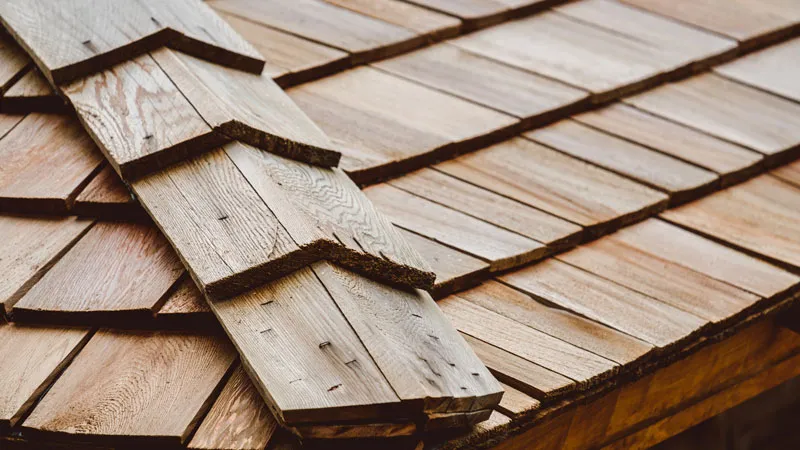
Frank Lloyd Wright rarely used asphalt shingles in his designs. Instead, he preferred roofing materials that complemented his emphasis on natural forms and integrated architecture. He favored materials that were both innovative and natural, aiming to create a seamless connection between his structures and their environments. Here are some of the roofing types he commonly used:
1. Clay Tiles
- Frequently used in his early Prairie-style homes, including the Martin House.
- The warm, earthy tones of clay tiles aligned with his philosophy of harmonizing with the natural environment.
2. Flat Roofs with Built-Up Roofing
- Used in many Usonian homes and later designs.
- These roofs often included layers of gravel, tar, or bitumen to create a seamless, functional surface.
- Flat roofs were part of his aesthetic for achieving a clean, modern horizontal line.
3. Copper Roofing
- Wright used copper for its durability and patina effect, which ages beautifully over time.
- Notable examples include Fallingwater, where copper roofs blend with the natural surroundings.
4. Concrete Roofs
- Found in some of his innovative designs, such as the S.C. Johnson Wax Headquarters.
- Concrete provided structural and sculptural possibilities, particularly for his non-residential projects.
5. Wood Shingles
- Used in some of his earlier works, particularly before the Prairie School period.
- Wood shingles were traditional and allowed for a rustic, natural look in harmony with the surrounding landscape.
6. Metal Roofs
- For some Usonian homes, he used sheet metal roofs to maintain simplicity and reduce costs while achieving a modern aesthetic.
7. Terracotta or Stone Slabs
- Occasionally used to create a durable and visually striking roofline, often seen in larger, public buildings like Unity Temple.
Affordable & Accessible Modern Roofing Alternatives:
If you’re looking for affordable and accessible roofing options that can mimic the aesthetic or spirit of Frank Lloyd Wright’s designs, here are some practical choices:
1. Metal Roofing (Standing Seam or Panels)
- Cost: Mid-range, but increasingly affordable.
- Why It Works: Metal roofing, especially in a matte finish, can replicate the clean, horizontal lines of Wright’s designs. It offers durability and sustainability, echoing his focus on innovation and longevity.
- Best For: Modern or Usonian-style homes with flat or low-pitched roofs.
- Bonus: Available in copper-like finishes for a patina effect without the high cost of real copper.
2. Fiber Cement or Composite Tiles
- Cost: Affordable to mid-range.
- Why It Works: Fiber cement tiles can mimic the look of natural clay or slate, achieving the warmth and texture Wright often sought. They’re lightweight and more affordable than traditional clay tiles.
- Best For: Prairie-style homes with hipped or sloped roofs.
- Bonus: Resistant to weathering and low maintenance.
3. Asphalt Shingles (Designer or Architectural Styles)
- Cost: Highly affordable.
- Why It Works: While basic asphalt shingles lack the elegance Wright desired, architectural shingles can mimic the texture and depth of wood or slate. Choose neutral earth tones to align with his naturalistic philosophy.
- Best For: Budget-conscious projects aiming for a classic aesthetic.
- Bonus: Widely available and easy to install.
4. Concrete Tiles
- Cost: Moderate, but more affordable than clay or slate.
- Why It Works: Concrete tiles can replicate the look of heavier, more expensive materials (like clay or stone) while providing durability. They suit Wright-inspired homes with low-pitched roofs.
- Best For: Prairie or Usonian homes where weight isn’t a concern.
- Bonus: Sustainable and available in various colors and textures.
5. Synthetic Slate or Shake
- Cost: Moderate to mid-range.
- Why It Works: These mimic the appearance of natural slate or wood shingles without the cost or maintenance. The refined look aligns with Wright’s preference for natural aesthetics.
- Best For: Projects requiring lightweight roofing with a high-end look.
- Bonus: Resistant to cracking and weathering.
6. Corrugated Metal with Natural Finishes
- Cost: Very affordable.
- Why It Works: Though simpler than standing-seam metal, corrugated panels in neutral or earth tones can provide a rustic, modern look reminiscent of Wright’s organic architecture.
- Best For: Usonian-inspired homes or accessory structures.
- Bonus: Sustainable and recyclable.
7. Green Roofs or Faux Living Roofs
- Cost: Moderate to high (depending on scope).
- Why It Works: While not a traditional material, a green roof (or synthetic alternatives) complements Wright’s focus on blending architecture with nature.
- Best For: Modern interpretations of Wright’s designs with flat roofs.
- Bonus: Improves insulation and sustainability.
Key Considerations:
- Low Pitch: Most of Wright’s designs relied on low-pitched or flat roofs, so choose materials that perform well in such applications.
- Earth Tones: Focus on natural or subdued colors (e.g., browns, greens, greys) to maintain harmony with the environment.
- Textures: Materials that mimic natural textures (wood, clay, stone) capture Wright’s emphasis on organic forms.
With thoughtful material selection, you can create a roof that resonates with Wright’s philosophy while staying within budget.
Here’s a breakdown of the average cost differences between the roofing types listed and standard asphalt shingles (based on cost per square foot, including materials and installation, early 2025):
| Roof Type | Cost ($/sq ft) | % Difference from Asphalt Shingles |
| Standard Asphalt Shingles | $3–$6 | Baseline |
| Architectural Shingles | $4.50–$7.50 | +10% to +50% |
| Corrugated Metal | $4–$8 | + 0% to +150% |
| Fiber Cement/Composite | $5–$10 | +25% to +200% |
| Synthetic Slate/Shake | $8–$12 | +75% to +300% |
| Standing Seam Metal | $6–$12 | +50% to +300% |
| Concrete Tiles | $10–$15 | +100% to +400% |
| Green Roof (Living/Faux) | $12–$50 | +300% to +1,500% |

